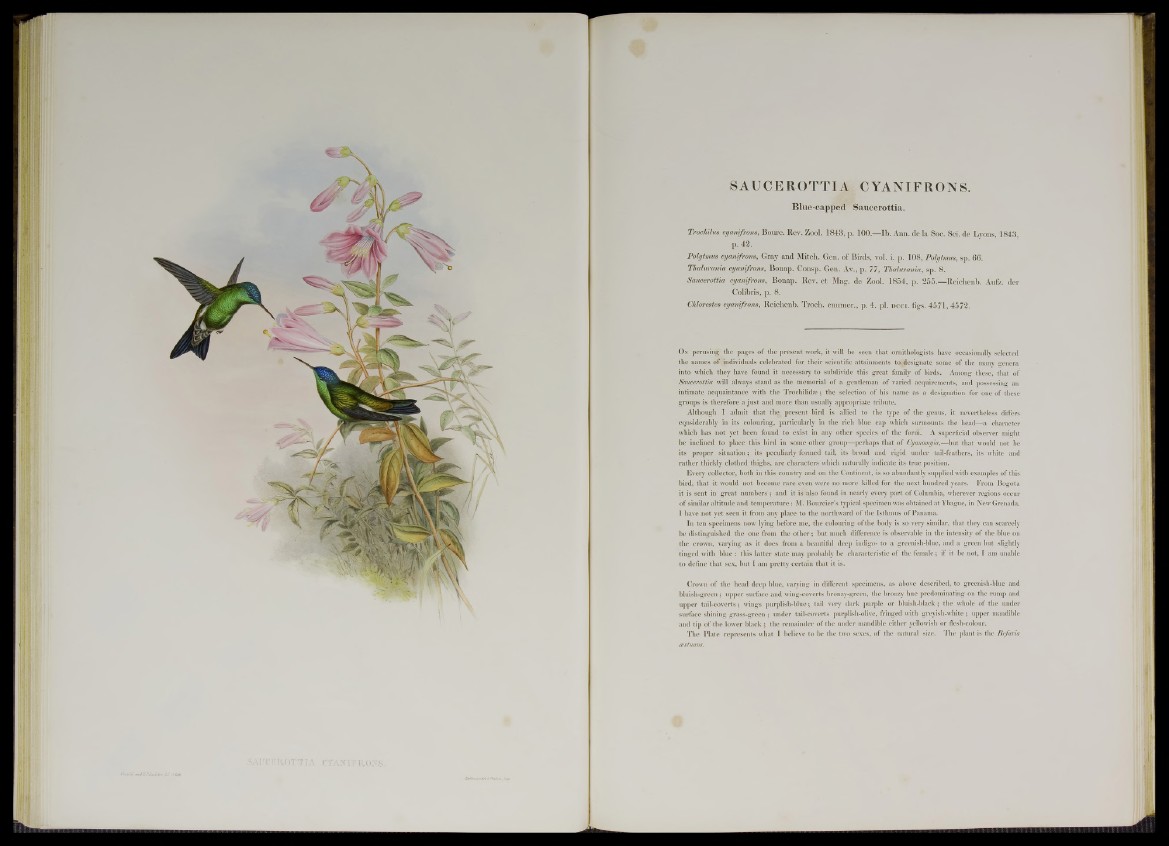
SAUCEROTTIA CYANIFRONS.
Blue-capped Saucerottia.
Trochilus cyanifrons, Bourc. Rev. Zool. 1843, p. 100.— Ib . Ann. de la Soc. Sci. de Lyons, 1843,
p. 42.
Polytmus cyanifrons, Gray and Mitch. Gen. of Birds, vol. i. p. 108, Polytmus, sp. 66.
Thalurania cyanif-ons, Bonap. Consp. Gen. Ay., p. 77, Thalurania, sp. 8.
Saucerottia cyanifrons, Bonap. Rev. e t Mag. de Zool. 1854, p. 255.—Reiclienb. Aufz. der
Colibris, p . 8.
Chlorestes cyanifrons, Reichenb. Troch. enumer., p. 4. pi. d c c i . figs. 4571, 4572.
O n perusing^. the pages of the present work, it will be seen that ornithologists have occasionally selected
the names of individuals celebrated for their scientific attainments to^ designate some of the many genera
into which they have found it necessary to subdivide this great family of birds. Among these, that of
Saucerottia will always stand as the memorial of a gentleman of varied acquirements, and possessing an
intimate acquaintance with the Trochilidse; the selection of his name as a designation for one of these
groups is therefore a just and more than usually appropriate tribute.
Although I admit that thet present bird is allied to the type of the genus, it nevertheless differs
cqnsiderably in its colouring, particularly in the rich blue cap which surmounts the head—a character
which has not yet been found to exist in any other species of the form. A superficial observer might
he inclined to place this bird in some other group—perhaps that of Cyanomyia,—but that would not be
its proper situation; its peculiarly formed tail, its broad and rigid under tail-feathers, its white and
rather thickly clothed thighs, are characters which naturally indicate its true position.
Every collector, both in this country and on the Continent, is so abundantly supplied with examples of this
bird, that it would not become rare even were no more killed for the next hundred years. From Bogota
it is sent in great numbers'; and it is also found in nearly every part of Columbia, wherever regions occur
of similar altitude and temperature: M. Bourcier’s typical specimen was obtained at Ybague, in New Grenada.
I have not yet seen it from any place to the northward of the Isthmus of Panama.
In ten specimens now lying before me, the colouring of the body is so very similar, that they can scarcely
be distinguished the one from the other; but much difference is observable in the intensity of the blue on
the crown, varying as it does from a beautifiil deep indigo- to a greenish-blue, and a green but slightly
tinged with blue : this latter state may probably be characteristic of the female; if it be not, I am unable
to define that sex, but I am pretty certain that it is.
Crown of the head deep blue, varying in different specimens, as above described, to greenish-blue and
bluish-green; upper surface and wing-coverts bronzy-green, the bronzy hue predominating on the rump and
upper tail-coverts; wings purplisli-blue; tail very dark purple or bluish-black; the whole of the under
surface shining grass-green ; under tail-coverts purplish-olive, fringed with greyish-white ; upper mandible
and tip of the lower black ; the remainder of the under mandible either yellowish or flesh-colour.
The Plate represents what I believe to be the two sexes, of the natural size. The plant is the Befaria
(sstuans.